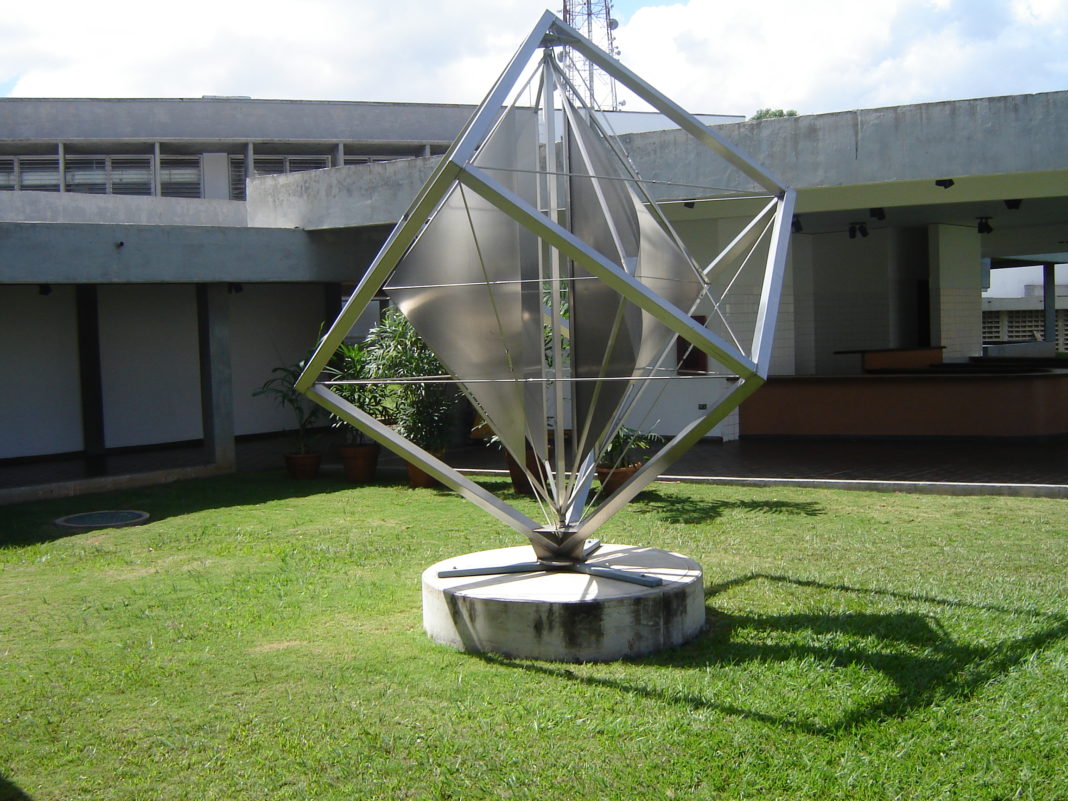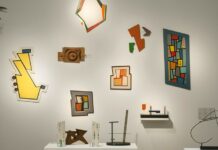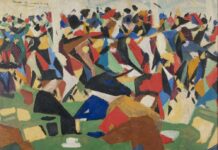ALEJANDRO OTERO b.1921, d.1990 VENEZUELA
Created between 1955 and 1960, Alejandro Otero’s color-rhythms are the consummated result of the artist’s explorations in the field of abstraction. Color-rhythm 34 is one of the ninety pieces that form this series, which is subdivided into eighty-four colorrhythms and six color-rhythms in motion. These works stemmed from a dialogue between Otero and the work of Mondrian in 1951. He created the color-rhythms by applying duco using an air gun or paint roller on enlarged rectangular plywood or Plexiglas bases. They are vertical or horizontal, but all of them follow the same pattern: a base structure comprised of regular intervals of dark stripes on a white background, inside which the artist evenly placed a series of geometric and colored planes—generally using primary colors. These geometric planes vary in number, size, shape, and frequency, and, by being inserted between the vertical stripes, activate the composition both in terms of color and rhythm. Hence the name color-rhythms. However, there seems to be something else. Just like in the work of Mondrian, Otero’s color-rhythms give the viewer a glimpse of his philosophical rumination. The structure in the background, with its regular stripes and well-defined contours, achieved through the use of adhesive tape, has a function similar to that of a musical score sheet or the lines in a notebook. It represents a sort of universal, objective, preordained, and immutable order. Meanwhile, the colored planes represent particular and subjective accidents, whose character is essentially expressive. Therefore, each color-rhythms ends up being a different colored song, written on the same musical score sheet. Venezuelan artist Alejandro Otero studied at the Escuela de Artes Plásticas in Caracas and broke through as an artist exhibiting realistic paintings at national salons in the early forties. However, a long stay in Paris (1945-1952) led him away from mimetic representations. A first stage (1946-1948) consisted of a series of variations on static subjects, such as coffeepots and chandeliers, combined with a gestural and colorful lyricism, structured with angular black lines. Exhibited at the Museo de Bellas Artes in Caracas in 1949, the works were controversial, but earned him a prominent place in Venezuela’s progressive movement. Nevertheless, after his return to Paris in 1950, he veered toward a more radical abstractionism. That same year, along with other fellow countrymen living in France, he formed Los Disidentes, a group that attacked Venezuelan artistic conservatism and promoted geometric abstraction. It was during that time that the influence of Piet Mondrian started to emerge, whose work he studied on a trip to the Netherlands in 1951. From then on, all of Otero’s work in the fifties conversed with the work of Mondrian: Líneas de color sobre fondo blanco (1951) and Collages ortogonales (1951-1952), both of which explore the optical and dynamic effects of line and color through the interweaving of paper strips of different colors; the murals and stained glass pieces he created for the project of Ciudad Universitaria de Caracas commissioned by Carlos Raúl Villanueva; and the celebrated color-rhythms he produced between 1955 and 1960 after becoming disappointed with the possibility of effective integration of architects and artists. It was through his color-rhythms that he gained international recognition. With those pieces he was included in the collection of the Museum of Modern Art in 1956, receiving the National Prize for painting at the Salón Nacional Venezolano in 1959, and an honorable mention at that year’s São Paulo Biennale. Between 1960 and 1964, he returned to Paris looking to explore new areas of his work. He experimented with collages, assemblage, and found objects. In the seventies, he began creating public outdoor sculptures in Latin America, the United States, and Europe. In 1971 he obtained a Guggenheim Fellowship and spent a season as a visiting artist at MIT.
Photo: Guillermo Ramos Flamerich













